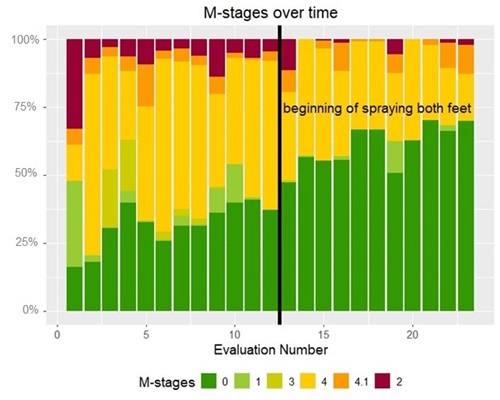HooFoss shows a significant prevention of digital dermatitis
A part of the trial was performed at a German farm with approx. 70 milking cows in house all year round. In the first year, the trial setup included a split-leg design where the rear right hooves were treated with HooFoss, and the rear left hooves did not receive any treatment. The second year both rear legs received HooFoss treatment. The front hooves were not treated in this trial.
All cows received hoof trimming, and all DD cases were registered. At the same time, all DD cases of concern (M1>1.5 cm, M2, M4 and M4.1) were treated with 66% salicylic acid ointment under a bandage. After 2-3 days, the bandages were removed and it was observed that there were no more open wounds, but that, in most cases, they had not fully healed. Two weeks after having finished the salicylic acid treatment, two weekly treatments with HooFoss were introduced. The application was done by a special battery-driven Milwaukee sprayer focusing on the hoof cleft and skin area above the rear hooves. The nozzle of the sprayer was placed directly in the hoof cleft for a short flushing and then continued while moving the nozzle out and further up on the skin area above the hooves.
The hoof specialists are primarily focused on reducing M2 and M4.1 because those acute conditions cause pain, lameness and reduced milk yield. M3 describes a painless DD wound in the healing phase. M4 includes chronic DD wounds with an overgrowth (wart-like) appearance, typically with no pain or lameness.
Level of digital dermatitis shown as mean M-score
In the first year, the level of DD on the control hooves did not decrease and remained on a constant high level. On the other hand, the hooves treated with HooFoss showed a significant prevention in DD, already after the first month. During the second year, where both rear hooves received HooFoss treatment, the former control hooves dropped to the level of the HooFoss treated hooves. See graph below:

The x-axis is the time as months and the y-axis is the mean M-score (see the table below for more info). The red graph represents the rear left hooves that received no treatment in the first year and HooFoss in the second year. The blue graph represents the rear right hooves that received HooFoss treatment both years. The black line divides the first and second year.
Level of Digital Dermatitis divided into M-stages

The x-axis represent the numbers of evaluations during the two year trial period.The y-axis represent the percentage of a specific M-stage out of the total. During the two-year trial period, the level of M0 (no DD) increased. At the same time, the level of chronical M4 and acute M2 and M4.1 decreased.
Behind Mean M-Score
Scoring of digital dermatitis according to the negative impact on the health of dairy cows
(Higher M-score indicate a higher negative impact on cow health)
| Appearance/Finding | Maximum length or width of lesion |
Score |
| M1 (without pain) | <1,0 cm | 1 |
| 1,0 - 1,5 cm | 2 | |
| 1,5 - 1,9 cm | 3 | |
| M2 (with pain) | ∼2,0 cm | 30 |
| 2,1 - 3,0 cm | 40 | |
| >3,0 cm | 60 | |
| M3 | <2,0 cm | 4 |
| 2,1 - 3,0 cm | 5 | |
| >3,0 cm | 6 | |
| M4 | <2,0 cm | 15 |
| 2,1 - 3,0 cm | 16 | |
| >3,0 cm | 17 | |
| M4.1 | <2,0 cm | 20 |
| M0 | 0 |
German trial shows positive effects of HooFoss in the Journal of Dairy Science
HooFoss has shown a high efficacy in the prevention of DD in dairy cows. Using the product substantially reduced the amount not only of active lesions but even the numbers of non-active lesions. Read more.
Learn more about HooFoss.

